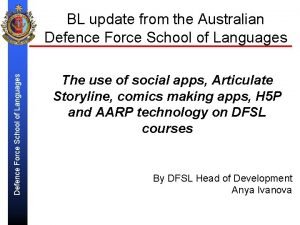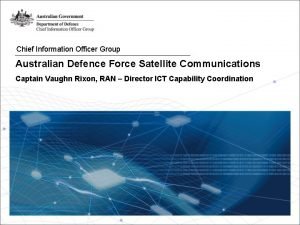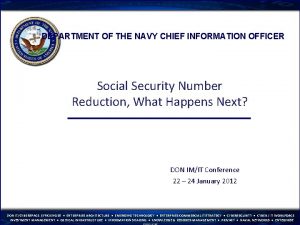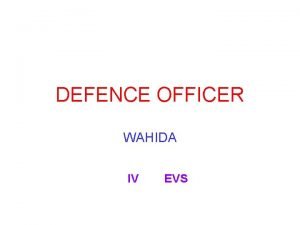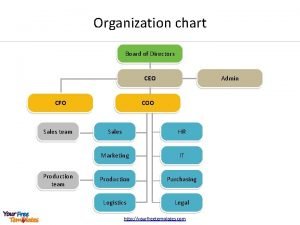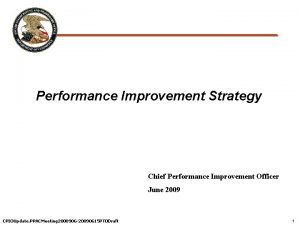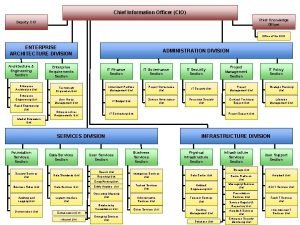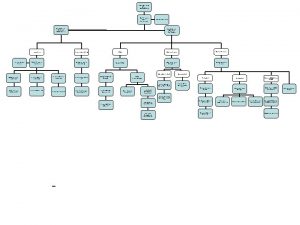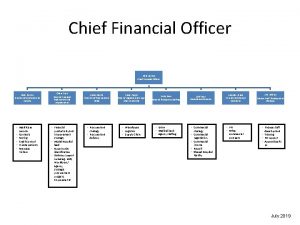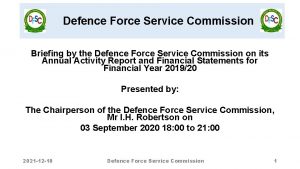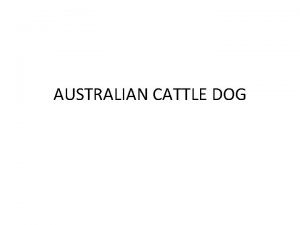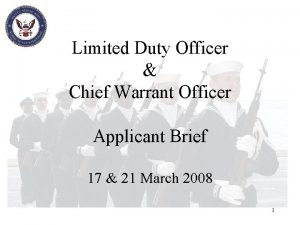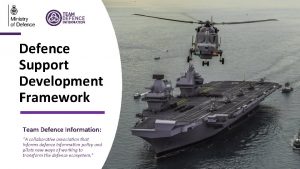Information Chief Information Officer Group Australian Defence Force














- Slides: 14

Information Chief Information Officer Group Australian Defence Force Satellite Communications Captain Vaughn Rixon, RAN – Director ICT Capability Coordination

Scope • • • ADF SATCOM Roles ADF Use of SATCOM Capability Construct SATCOM Capability – Today SATCOM Capability – Tomorrow Future Challenges

ADF SATCOM Broad Roles CIOG/CDG DMO CIOG Terminal Services/CDG DMO Services Ground CIOG/CDG DMO CIOG Build Run Space Plan CIOG CDG = = Chief Information Officer Group Capability Development Group DMO = Services = Defence Materiel Organisation Navy, Air Force and Army

ADF Use of SATCOM • Operational Environment – Characterised by concurrent operations, in dispersed locations, with a requirement for extension of Defence networks/voice services from the strategic environment into the operational and tactical domains • SATCOM provides independent communications means – Operations can not rely solely on terrestrial connectivity – may be compromised or not available – Users may not be within line-of-sight, or in terrain constrained environment (urban, mountainous regions) – SATCOM can achieve long distance connectivity (trunking) and netted communications • Accordingly, cardinal requirements of coverage, capacity and connectivity endure

Capability Construct

SATCOM Cardinal Requirements – The Ends • Coverage – Ongoing operational requirement for ‘Two Ocean Presence’ (Indian and Pacific) – ADF’s Primary Operational Area (White Paper) – Australian Coverage Area of 30°E to 170°W (WGS MOU) – Contingency requirement for Rest of World coverage • Capacity – Increasing demand for bandwidth (new capabilities being introduced) – New platforms, high data rate ISR streams, increased demand at HQ – Current predictions suggest capacity requirements can be met; however, regular Information Exchange Requirements (IER) analysis is essential. • Connectivity – Extending strategic information networks into the operational arena – Increasing use of coalition networks – Growing need for netted communications

SATCOM Cardinal Requirements – The Ends Zone 3 Zone 2 Zone 3 West East Capacity Zone 1

Current Capability – The Ways • Space Segment – Need for wideband narrowband SATCOM remains extant – Wideband primarily for long-haul communications supporting larger semi-static formations – Narrowband primarily for mobile, tactical users with strategic and netted links – Expect increased mobile wideband access as small wideband dishes are introduced – Aim to converge on military systems and spectrum (WGS / DPS / IS-22) – Commercial SATCOM will continue to be required for alternate means, surge or where military spectrum can not be used • Terminal Segment – Classified as either platform-based, transportable or anchor terminals – Platform-based are the responsibility of the project introducing the major capability – Significant change to Defence’s transportable terminals out to 2016 to facilitate the convergence on MILSATCOM (military spectrum and systems) – Likewise, major changes to Defence’s anchoring architecture to accommodate WGS, IS-22, TDMA, IW

Current Capability – The Ways • Control Segment – Defined as platform (satellite) monitoring and control (M&C) or transmissions and payload M&C – Platform (station keeping, sub-system health monitoring) – Defence not directly involved in platform M&C of bus – WGS M&C is through US MILSATCOM architecture. – DPS and IS-22 M&C is included in commercial contracts – Payload (circuit configuration, traffic monitoring) – Defence maintains M&C on DPS – WGS influenced through close liaison with all agencies in the US architecture – IS-22 and others through coordination with the commercial provider • Network Segment – Provides the interfaces to the strategic networks and connectivity between anchor and control sites – The most significant change to the network segment in the near future will be convergence on IP switching

Space and Anchor Segment Capability - Today Military Wideband • • • Optus C 1 (X and Ka) • SGS-H WGS 1 -4 (X and Ka) • IAS East and West • OSA Bi-lat MOUs Military Narrowband • • • Optus C 1 • NCS East and West (DAMA) IS-22 • NCS West and North (DAMA) AUS/USA MOU Commercial Wideband • • • Optus D 1 (Ku) • Defence owned and operated anchors NSS-6 (Ku) • Combo Defence owned and leased IS-906 (C) • Leased anchor Commercial Narrowband • • • Iridium (Voice) Inmarsat (Legacy) Optus B 3 (Voice and BFT)

Space and Anchor Segment Capability - Tomorrow Military Wideband • • • Optus C 1 (X and Ka) • SGS-H and SGS-W WGS 1 -6 (X and Ka) • SGS-E and SGS-W • OSA Bi-lat MOUs Military Narrowband • • • Optus C 1 • NCS PER and CBR (IW) IS-22 • NCS PER and DWN (IW) AUS/USA MOU Commercial Wideband Commercial Narrowband • • Gateway Xpress? Managed services Iridium (New applications) Inmarsat (IP)

Future Challenges • Enhanced UHF SATCOM Capability (JP 2008 PH 5 A and AUS/US UHF MOU) – AT&E/OT&E – Coordinating change to control segment – Combined operations with US • Changes to Australian Wideband anchoring – Interim anchoring (WGS) – SGS(W) – SGS(E) • • • Introduction of new SATCOM terminals and platforms New technologies (IW, TDMA, IP) New capabilities – Protected SATCOM, DTCS, L-Band TACSAT Maintaining GEO orbit slots (IOR and POR) Sustaining the SATCOM Capability (WGS follow-on)

Questions

JP 2008 – Wideband Military SATCOM Ph 4 WGS Ph 3 D Ph 4 OPTUS C 1 Ph 4 Ph 5 B 2 Ph 3 F DNOC Network Management SGS-W Ph 5 B 2 Pre -2 nd Pass SGS-E Ph 3 F SGS-HAR Post -2 nd Pass Strategic Network Infrastructure Ph 3 E MASTIS Tactical Network Infrastructure Ph 3 H Initial Tranche of Land Terminals Ph 5 B 1 Remainder of Land Terminals
 Gintplay
Gintplay Jp9102
Jp9102 Office of the government chief information officer
Office of the government chief information officer Department of the navy chief information officer
Department of the navy chief information officer Wahida prism images
Wahida prism images Who is wahida prism class 4
Who is wahida prism class 4 Chapter 9 lesson 3 commander in chief and chief diplomat
Chapter 9 lesson 3 commander in chief and chief diplomat Chief knowledge officer job description
Chief knowledge officer job description Chief data officer training
Chief data officer training Ceo coo
Ceo coo Chief improvement officer
Chief improvement officer Adolfo gonzales chief probation officer
Adolfo gonzales chief probation officer Chief happiness officer portugal
Chief happiness officer portugal Chief reality officer
Chief reality officer Chief instructional officer
Chief instructional officer
